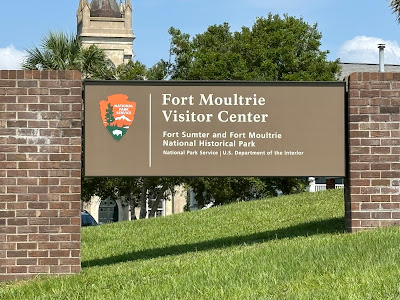Our travels took us next into South Carolina where we visited Fort Moultrie.
The Fort Moultrie Visitor Center was built in 1976 where the hospital of the fort once stood.
The first fort on Sullivan's Island was still incomplete when the Royal Navy and nine British men-of-war attacked it on June 28, 1776. After a nine-hour battle, the British ships were forced to retire and Charlestown was saved from occupation. In May 1780, the British finally captured Charlestown, including Fort Moultrie. The city was evacuated in December, 1782 as the Revolution entered its final year.
After the Revolution, Fort Moultrie was neglected and by 1791 little of it remained. Then, in 1793, war broke out between Great Britain and France. The next year Congress, seeking to safeguard American shores, authorized the first system of nationwide coastal fortifications. A second Fort Moultrie, one of twenty new forts along the Atlantic coast, was completed in 1798. It also suffered from neglect and was finally destroyed by a hurricane in 1804. By 1809 a new brick fort stood on Sullivan's Island.
Fort Entrance
In the months leading up to the Civil War, John L. Gardner was in command at Fort Moultrie. With secession growing more imminent, Gardner had made several requests to the Secretary of War, John B. Floyd, for more troops to command the undermanned fortress. Each time his requests were ignored as Floyd (who joined the Confederacy) was planning to hand the forts in the harbor over to the secessionists.
South Carolina seceded from the Union on December 20, 1860, after the first election of President Lincoln. Around this time a Federal garrison was sent to Fort Moultrie but unlike the state militia at the other forts, the defenders of Fort Moultrie chose not to surrender to the South Carolina forces. On December 26, 1860, Union Major Robert Anderson moved his garrison from Fort Moultrie to the stronger Fort Sumter.
Major Robert Anderson
Major Anderson, from Kentucky, commanded the U.S. Army garrison at Fort Sumter at the outbreak of the Civil War. Anderson, like many experienced officers of the Civil War, fought in the Mexican-American War.
In November 1860, Major Anderson took command of the Federal forces in Charleston Harbor, which totaled about eighty men who were primarily garrisoned in Fort Moultrie as Fort Sumter was still under construction. Anderson had been selected for the command given the growing tensions since Abraham Lincoln's victory in the 1860 presidential election for his competence, southern roots, sympathy for slavery, and his loyalty to the Union.
On February 8, 1861, South Carolina joined the five other seceded Deep Southern states to form the Confederate States of America. In April 1861, Confederate troops shelled Fort Sumter into submission and the Civil War began.
In 1863, the Federal Army began a bombardment of Fort Moultrie and the other forts around the harbor. In 1865, as General Sherman marched through South Carolina, the Confederate soldiers finally abandoned the rubble of Fort Moultrie and evacuated the city of Charleston.
There are stairs that take you to the top of the fort - the views were spectacular.
Visitor Center
On August 15, 1947, the Army lowered Fort Moultrie's flag for the last time and ended 171 years of service. After the war, due to changes in military technology, including submarines and nuclear weapons, seacoast defense of the United States ceased to be a viable strategy.
In 1960, the Department of Defense transferred Fort Moultrie to the National Park Service. Today, Fort Moultrie has been restored to show the major periods of its history from 1809 through 1947.
We left the fort to explore other areas of the park.
This building was the torpedo storage building for the fort; today it serves as office space.
In the back of the Visitor Center you can walk to the intracoastal waterway.
Though he was of mixed heritage (his birth name was Billy Powell), Osceola was raised as a Creek Indian by his mother, and after the family moved to Florida in 1814 he rose to become an influential leader of the Seminole Indiana tribe. He achieved notoriety by leading a group of native warriors fighting against federal occupation during the Second Seminole War.
Unfortunately, Osceola was captured at St. Augustine in 1837 in a controversial encounter - Army troops lured the Seminole leaders into their trap by deceptively using a flag of truce. After this capture, the chief was transferred to a prison cell on the grounds of Fort Moultrie.
In 1780, General Moultrie was captured when the British returned to Charleston. After the war ended, Moultrie returned to politics, serving in the South Carolina House and Senate and as both lieutenant governor and governor. He died in 1805 and was buried in the family cemetery. In 1977, archaeologists discovered the resting place and in 1978, his remains were moved to Fort Moultrie.
What a great stop!




















My daughter just celebrated her birthday with her friends in Charleston, but I doubt she went to this site.
ReplyDeleteI would love to see a map showing your route and travels---it seems you are sort of wandering east, west, north, south and going back and forth??
We don't really have a long term plan (or map) but just decide where we want to go next. Since we typically only travel about 4 hours at a time, we make a lot of stops along the way and see a lot of things. Fortunately, we're long gone from the the upcoming storm area.
DeleteOh, I meant a map of where you've already been, not where you're going next!
DeleteI use an app and break it down into "trips" so no way to show in one place where we've been. Plus, we've zig zagged the country so much it would be a mess. Three different visits to Florida, two trips back to Washington, and many points in between
Delete